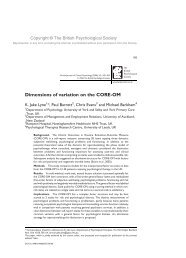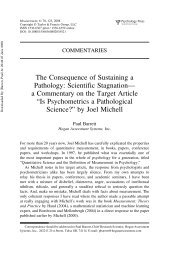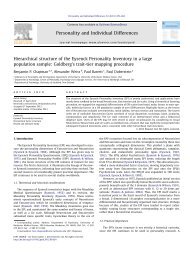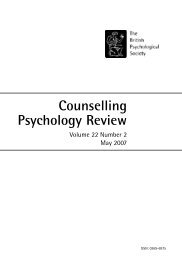Psychophysiological Methods - Paul Barrett
Psychophysiological Methods - Paul Barrett
Psychophysiological Methods - Paul Barrett
- No tags were found...
You also want an ePaper? Increase the reach of your titles
YUMPU automatically turns print PDFs into web optimized ePapers that Google loves.
Breakwell-3389-Ch-08.qxd 2/7/2006 8:49 PM Page 154evoked potentialelectroencephalography(up to more than 300 with high-density EEG recording). These electrodes are usedto record voltage differences between one or more cortical sites and a relatively electricallyinactive area (such as an earlobe). For magnetoencephalograph recording,superconducting quantum interfering devices (SQUIDs) are used to detect theminute dynamically fluctuating magnetic fields within the brain. Unlike EEG electrodes,SQUIDs do not have to be in contact with the scalp or cortical tissue as thereis no reliance on electrical conductivity of electrons through body tissues.The electrical signals emanating from the brain are very small (of the order ofmicrovolts). Spontaneous electroencephalography is the term used to describe thecontinuous stream of activity that is always present within the brain. This activitycan be characterized as patterns of oscillatory waveforms that have conventionallybeen subdivided in terms of their frequency into four main bands: delta (low frequency,0.5–4 Hz; amplitude 20–200 µV), theta (low frequency, 4–7 Hz; amplitude20–100 µV), alpha (dominant frequency, 8–13 Hz; amplitude 20–60 µV) and beta(high frequency, 13–40 Hz; amplitude 2–20 µV). Electroencephalography has frequentlybeen used to study levels of arousal from deep sleep, where delta activitypredominates, through to alert attentiveness, where beta activity predominates.If, instead of recording the spontaneous activity of the brain, a brain responseis evoked by a quantifiable stimulus, then it is possible to examine the change inelectrical activity in direct response to a known stimulus. This technique is knownas evoked potential electroencephalography. Some of these evoked potentials canlast less than 10 ms (such as the brain-stem auditory evoked potential generatedby subcortical brain tissues) or up to a second or longer as in the case of the Bereitschaftspotentialor readiness potential (a slow shift in voltage that is observed aspreceding voluntary or spontaneous movement within an individual). Generally,because of the low level of brain response over and above the normal backgroundelectroencephalographic activity, many evoked responses are collected and thensummed to produce an average evoked response (AER), also known as an averageevoked potential (AEP). The basis for this summation is that activity in the waveformthat is not generated in response to the stimulus will be almost random andhence sum to near zero over occasions, while activity that is related to the stimuluswill be enhanced by adding these stimulus-generated signals together.For spontaneous EEG data, the most popular method of analysis is based arounda mathematical technique known as Fourier analysis. This decomposes the complexEEG waveform into simple separate oscillating components each having aparticular frequency of oscillation and magnitude. Following this, the amount ofelectrical energy accounted for by each particular frequency that could possiblymake up the complex waveform provides direct, quantitative measures that indexsignal power at certain frequencies. More recent methods of analysis have reexpressedmulti-electrode output as a spatial contour map – the topographical EEGmap. This is a method of interpolating activity between electrodes in order toproduce a set of smoothed gradients that can be ‘mapped’ over the surface of the154 RESEARCH METHODS IN PSYCHOLOGY












